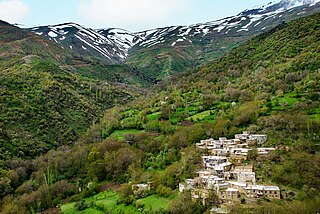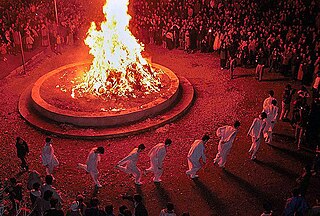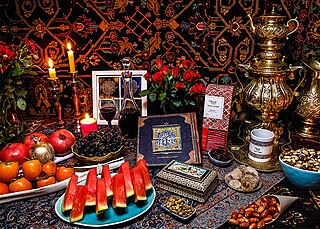Related Research Articles
The Persians are a Western Iranian ethnic group who comprise the majority of the population of Iran. They share a common cultural system and are native speakers of the Persian language as well as of the languages that are closely related to Persian.
The Iranian calendar or Iranian chronology are a succession of calendars created and used for over two millennia in Iran, also known as Persia. One of the longest chronological records in human history, the Iranian calendar has been modified many times for administrative purposes. The most influential person in laying the frameworks for the calendar and its precision was the 11th century Persian polymath, Omar Khayyam. The modern Iranian calendar is currently the official civil calendar in Iran.

Nowruz is the Iranian New Year or Persian New Year. Historically, it has been observed by Persians and other Iranian peoples, but is now celebrated by many ethnicities worldwide. It is a festival based on the Northern Hemisphere spring equinox, which marks the first day of a new year on the Solar Hijri calendar; it usually coincides with a date between 19 March and 22 March on the Gregorian calendar.

Kurdistan province is one of 31 provinces of Iran. The province is 28,817 km2 (11,126 sq mi) in area and its capital is the city of Sanandaj.

Chaharshanbeh Suri or Charshanbeh Suri, is an Iranian festival of the fire dance celebrated on the eve of the last Wednesday of the year, of ancient Zoroastrian origin. It is the first festivity of Nowruz, the Iranian New Year.

Sadeh, is an Iranian festival that dates back to the Achaemenid Empire. Sadeh is celebrated 50 days before Nowruz. Sadeh in Persian means "hundred" and refers to the one hundred days and nights remaining to the beginning of spring. Sadeh is a mid-winter festival that was celebrated with grandeur and magnificence in ancient Persia. It was a festivity to honor fire and to defeat the forces of darkness, frost, and cold.

Tirgan, is an early summer ancient Iranian festival, celebrated annually on Tir 13. It is celebrated by splashing water, dancing, reciting poetry, and serving traditional foods such as spinach soup and sholezard. The custom of tying rainbow-colored bands on wrists, which are worn for ten days and then thrown into a stream, is also a way to rejoice for children.
Sepandārmazgān or Espandegān (اسپندگان), is an ancient Iranian day of women with Zoroastrian roots dating back to the first Persian Empire, the Achaemenid Empire. This day is dedicated to Spənta Ārmaiti, the Amesha Spenta who is given the domain of "earth". The date of the festival as observed in the Sassanid era was on the 5th day of the month Spandarmad. When the name of the day and the month of the day were the same, a "name-feast" celebration was always done. According to the testimony of al-Biruni, in the 11th century CE there was a festival when the names of the day and the month were the same. The deity Spandarmad protected the Earth and the "good, chaste and beneficent wife who loves her husband". According to him, the festival used to be dedicated to women, and men would make them "liberal presents", and the custom was still flourishing in some districts of Fahla.
Mordad is the fifth month of the Solar Hijri calendar, the official calendar of Iran and Afghanistan. Mordad has thirty-one days, beginning in July and ending in August of the Gregorian calendar. It is the second month of summer after Tir, and is followed by Shahrivar. The Afghan Persian name is Asad; in Pashto it is Zmaray. The name is derived from Ameretat, the Zoroastrian divinity/divine concept of immortality.

Sizdah Bedar, also known as Nature's Day, is an Iranian festival held annually on the thirteenth day of Farvardin, the first month of the Iranian calendar (and the first month of spring, during which people spend time picnicking outdoors. It marks the end of the Nowruz holidays in Iran.

Yaldā Night (Persian: شب یلدا, romanized: shab-e yaldâ or Chelle Night is an ancient festival in Iran, Afghanistan, Azerbaijan, Uzbekistan, Tajikistan, Turkmenistan that is celebrated on the winter solstice. This corresponds to the night of December 20/21 in the Gregorian calendar, and to the night between the last day of the ninth month and the first day of the tenth month of the Iranian solar calendar.The longest and darkest night of the year is a time when friends and family gather together to eat, drink and read poetry and Shahnameh until well after midnight. Fruits and nuts are eaten and pomegranates and watermelons are particularly significant. The red colour in these fruits symbolizes the crimson hues of dawn and the glow of life. The poems of Divan-e Hafez, which can be found in the bookcases of most Iranian families, are read or recited on various occasions such as this festival and Nowruz. Shab-e Yalda was officially added to UNESCO Intangible Cultural Heritage Lists in December 2022.
Iranian folklore encompasses the folk traditions that have evolved in Greater Iran.

The Solar Hijri calendar is the official calendar of Iran. It is a solar calendar and is the one Iranian calendar that is the most similar to the Gregorian calendar, being based on the Earth's orbit around the Sun. It begins on the March equinox as determined by the astronomical calculation for the Iran Standard Time meridian and has years of 365 or 366 days. It is sometimes also called the Shamsi calendar, Khorshidi calendar, or Persian calendar. It is abbreviated as SH, HS, AP, or, sometimes as AHSh, while the lunar Hijri calendar is usually abbreviated as AH.

Mahtab Keramati is an Iranian actress. She has received various accolades, including a Crystal Simorgh, two Hafez Awards. In August 2006, she was appointed as UNICEF Goodwill Ambassador in Iran.
Morad Qoli is a village in Qaratureh Rural District, in the Central District of Divandarreh County, Kurdistan Province, Iran. At the 2006 census, its population was 189, in 43 families. The village is populated by Kurds.

Iran Pride Day, National Day of Iranian LGBTs, or National Day Of Sexual Minorities is an annual LGBT pride event held on the fourth Friday of July in Iran since 2010.

On 3 August 1979, Constitutional Convention election was held in Tehran Province constituency with plurality-at-large voting format in order to decide ten seats for the Assembly for the Final Review of the Constitution
Persian astronomy or Iranian astronomy refers to the astronomy in ancient Persian history.